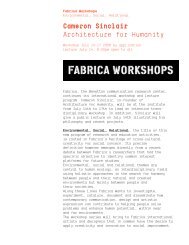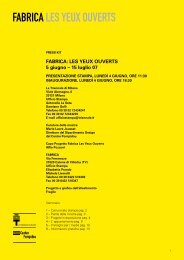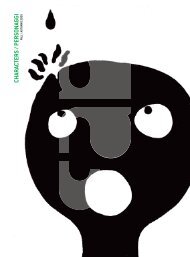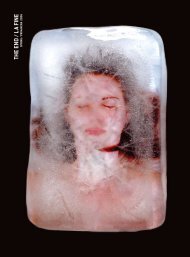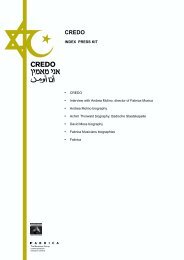F A B M A G A Z IN E / M A Y -J U N E 2 0 0 4 - fabrica
F A B M A G A Z IN E / M A Y -J U N E 2 0 0 4 - fabrica
F A B M A G A Z IN E / M A Y -J U N E 2 0 0 4 - fabrica
Create successful ePaper yourself
Turn your PDF publications into a flip-book with our unique Google optimized e-Paper software.
Uncle Bill<br />
We came to know Uncle Bill in 1992. He was a former CIA agent and after his retirement had bought<br />
himself a desolate piece of land near the Burmese border. The area had already been deforested<br />
and so he found only barren grass and red patches of soil on his land. In just a few months he built<br />
himself a two-story wooden house, his only guidance being a “DIY” publication in many volumes.<br />
Simultaneously he began to plant his 35 acres of land with teak and other types of trees that had<br />
been growing densely there just a few years previously. He also founded a gibbon sanctuary, and<br />
sheltered gibbons who had lost their families and natural habitats. Apes which had been shot at,<br />
or left to vegetate chained up in backyards.<br />
So when we got to know Uncle Bill in 1992, ‘Highland Farm’ already had a surreal atmosphere. You<br />
could hear the apes’ cackling from far away. It was an island of green in the midst of this barren<br />
land. A world of variety among monocultures. This impression was reinforced when I visited him again<br />
in 1997 and 1999. Giant teak trees, green thicket, but also coffee, fruit and vegetables. Several<br />
enclosures with gibbons, lemurs, macaques, an old bear, dogs, cats, turkeys.<br />
Then, contact was broken off. Only in 2002 did I hear about Uncle Bill again. My father rang me<br />
with a voice full of tears.<br />
>>>>>>>>>>>>>>>>>>>>>>>>>>>>>>>>>>>>>>>>>>>>>>>>>>>>>>>>>>>>>>>>>>>>>>>>>>>>>>>>>>>>>>>>>>>>>>>>>>>>>>>>>>>>>>>>><br />
>>>>>>>>>>>>>>>>>>>>>>>>>>>>>><br />
Uncle Bill<br />
Conoscemmo Uncle Bill nel 1992. Era un ex agente della CIA e, dopo essere andato in<br />
pensione, si era comprato un pezzo di terra brulla vicino al confine con la Birmania. La zona era<br />
già stata disboscata e così, sul suo terreno, trovò solo erba secca e chiazze di terra rossa. Nel<br />
giro di qualche mese si era costruito una casa di legno a due piani, seguendo semplicemente le<br />
istruzioni di una guida in più volumi al “Fai-da-te”. Contemporaneamente aveva cominciato a piantare<br />
nei suoi 35 acri di terra teak e altri tipi d’alberi, che fino a qualche anno prima crescevano fitti<br />
in quei luoghi. Fondò anche il santuario delle scimmie, e dava rifugio ai gibboni che<br />
avevano perso sia la famiglia che il loro habitat naturale. Scimmie con ferite d’arma da fuoco,<br />
o lasciate a vegetare incatenate in un cortile.<br />
Così quando conoscemmo Uncle Bill, nel 1992, a ‘Highland Farm’, regnava già un’atmosfera surreale.<br />
Si sentivano gli schiamazzi delle scimmie da lontano e il posto era un’isola di verde in mezzo a una<br />
landa desolata. Un mondo diverso in mezzo a mondi tutti uguali. Anche nelle mie visite seguenti ebbi<br />
la stessa impressione, nel 1997 e 1999. Giganteschi alberi di teak, un boschetto verde, e piante<br />
di caffè e alberi da frutta e verdure. Vari recinti con gibboni, lemuri, macachi e vecchi orsi. <br />
Cani, gatti, tacchini.<br />
Poi, i rapporti s’interruppero. Fu solo nel 2002 che ebbi di nuovo notizie di Uncle Bill.<br />
Mi telefonò mio padre con la voce spezzata dalle lacrime.<br />
>>>>>>>>>>>>>>>>>>>>>>>>>>>>>>>>>>>>>>>>>>>>>>>>>>>>>>>>>>>>>>>>>>>>>>>>>>>>>>>>>>>>>>>>>>>>>>>>>>>>>>>>>>>>>>>>><br />
>>>>>>>>>>>>>>>>>>>>>>>>>>>>>>>>>>>>>>>>>>>>>>>>>>>>>>>>>>>>>>>><br />
06 / 07



